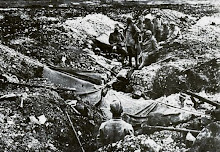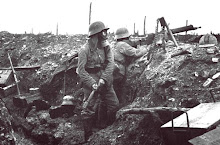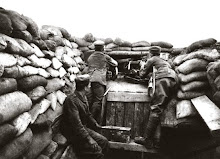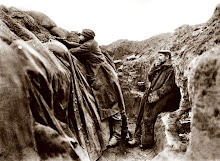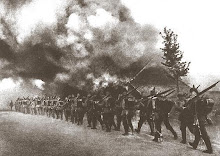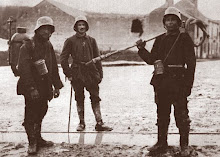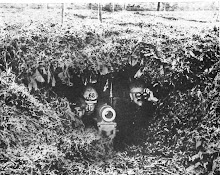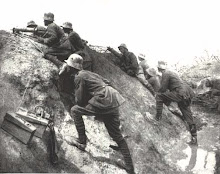Helen Burrey worked on a hospital train during the span of the war (World War I.) Through out the war she wrote about what happened on the hospital train she was on. Here are some of the things that she said.
"The rest of the train consisted of sixteen coaches, including one infectious car which carried eighteen beds; one staff car which carried eight beds; one kitchen and sitting sick officers' car which carried three beds and twenty seats; eight ordinary lying ward cars which carried 288 beds; one pharmacy car; one infectious case sitting car which carried fifty-six seats and fourteen upper berths; one kitchen and mess car with three beds for cooks; one personnel car with thirty beds and one train crew and store car; the total capacity of the train was thus 400 beds.Each moving hospital was equipped with electric lights, steam heat, electric fans, lavatories and racks for personal belongings and even ash trays for the patients' indulgence. There were eight ordinary ward cars for patients containing thirty-six beds arranged in tiers of three. These could easily be converted into seats to accommodate patients who were able to sit up; they could also be used for stretchers in emergency cases or folded against the sides of the coach when the cars required cleaning."
In summary she talked about living conditions, the wounded that she had to treat and just about her life on the train.
Thursday, January 10, 2008
Monday, October 29, 2007
Schlieffen Plan
The Schlieffen Plan is the forensic plan that was the German General Staff's overall strategic plan for victory both on the Western Front against France and against Russia in the east. we were taking advantage of expected differences in the three countries' speed in preparing for war.
It was executed to near victory in the first month of World War I; however, the French counterattacked on the outskirts of Paris, the Battle of the Marne (combined with surprisingly speedy Russian offensives), ended our offensive and resulted in years of trench warfare. The plan has been the subject of debate among historians and military scholars ever since.
The Schlieffen Plan was created by Alfred Graf von Schlieffen.

It was executed to near victory in the first month of World War I; however, the French counterattacked on the outskirts of Paris, the Battle of the Marne (combined with surprisingly speedy Russian offensives), ended our offensive and resulted in years of trench warfare. The plan has been the subject of debate among historians and military scholars ever since.
The Schlieffen Plan was created by Alfred Graf von Schlieffen.
The Red Baron
The Red Baron is formally known as Manfred von Richtofen. He was a world war I German flying ace, also known as "le Diable Rouge" ("Red Devil") or "Le Petit Rouge" ("Little Red") Richthofen received the Pour le Mérite, the highest military honour in Germany. He also received
.Prussian Pour le Mérite Order: 12 January 1917 (in recognition of his 16th aerial victory).
• Prussian Red Eagle Order, 3rd Class with Crown and Swords: 6 April 1918 (in recognition of his 70th aerial victory).
• Prussian Royal Hohenzollern House Order, Knight’s Cross with Swords: 11 November 1916.• Prussian Iron Cross, 1st Class (1914)
and many other medals through out the campaign. Manfred was killed on April 21, 1918 while he was flying over Morlancourt Ridge, near the Somme River.

.Prussian Pour le Mérite Order: 12 January 1917 (in recognition of his 16th aerial victory).
• Prussian Red Eagle Order, 3rd Class with Crown and Swords: 6 April 1918 (in recognition of his 70th aerial victory).
• Prussian Royal Hohenzollern House Order, Knight’s Cross with Swords: 11 November 1916.• Prussian Iron Cross, 1st Class (1914)
and many other medals through out the campaign. Manfred was killed on April 21, 1918 while he was flying over Morlancourt Ridge, near the Somme River.

Poison Gas
The French were the first to use chemical weapons during the First World War, using tear gas. The German's first use of chemical weapons were shells containing xylyl bromide that were fired at the Russians near the town of Bolimów, Poland in January 1915, The first full-scale deployment of chemical weapon agents was during World War I, originating in the Second Battle of Ypres, April 22, 1915, when the Germans attacked French, Canadian and Algerian troops with chlorine gas. Deaths were light, though casualties relatively heavy. A total 50,965 tons of pulmonary, lachrymatory, and vesicant agents were deployed by both sides of the conflict, including chlorine, phosgene and mustard gas. Official figures declare about 1,176,500 non-fatal casualties and 85,000 fatalities directly caused by chemical weapon agents during the course of the war.
No Mans Land
No Mans Land was the area of land between the two opposing armies in their trench's. This hellish stretch of land was heavily guarded by machine guns and rifle men, on both sides. It was riddled with barbed wire and dead or wounded men, and due to the intense bombing that this land endured no foliage or life of any kind, nothing grew or lived here. The only thing left was the craters that the artillery and planes left behind. Wilfred Owen discribed "The No Mans Land" in his poem.
"No Man's Land is pocketmarked like the body of foulest disease and its odour is the breath of cancer...No Man's Land under snow is like the face of the moon, chaotic, crater-ridden, uninhabitable, awful, the abode of madness."
"Hideous landscapes, vile noises....everything unnatural, broken, blastered; the distortion of the dead, whose unburiable bodies sit outside the dug-outs all day, all night, the most execrable
sights on earth." - Wilfred Owen

"No Man's Land is pocketmarked like the body of foulest disease and its odour is the breath of cancer...No Man's Land under snow is like the face of the moon, chaotic, crater-ridden, uninhabitable, awful, the abode of madness."
"Hideous landscapes, vile noises....everything unnatural, broken, blastered; the distortion of the dead, whose unburiable bodies sit outside the dug-outs all day, all night, the most execrable
sights on earth." - Wilfred Owen

Battlefeild Orders
Weapons:
April 14, 1915
Woke up this morning to the sounds of explosions. It was the third time this week that the French had hit us with their mortars. Now these 3" Mortars were capable of firing high explosive grenades or gas bombs into our trenches so naturally this made them an even greater annoyance than ever. The good thing is that the winds been picking up lately so most of their shells have missed us completely. I've heard rumors that were getting our own battery sometime in the near future.
April 15, 1915
nothing happened
April 16, 1915
Today nothing happened until around noon. This was the time when we were getting new recruits and since they had never been a battle let alone a front line trench, we had to give them basic training and teach them all about Trench Warfare. Now it wasn't all bad the recruits brought us more ammo, guns, food, all the good stuff. But one weapon really caught my eye, it was the flamethrower. Now other than being very cumbersome these flamethrowers could spit fire up to 18 meters, but to use it safely it had to be fired from inside a trench, so this weapon will be rarely used. Now thats a shame.
April 17, 1915
nothing happened
April 18, 1915
Went back from the line for a few hours to get some food and rest
April 19, 1915
Changed positions in the Trench. I was moved 5 miles down the line. When i got there i was glad to see that it was a well fortified well defended and to my surprise i found that they had two tanks wedged into the trench, one was female, and the other one was male. Now the female one only had a few machine guns mounted on it but the male had a large caliber gun. So all in all i feel pretty safe here.
April 21, 1915
started setting up our new machine gun positions near the front lines. Then around noon we stopped and ate some of those rations they handed out the other day. Well all i have to say is this, it was better than nothing.
April 22, 1915
Around 3:00 in the morning we started hearing our planes flying over making supply drops. Around 4:00 we had gotten all our supplies out of the no mans land and only had a few casualties. Then at 5:00 our planes started striping the French trenches. Other than that it was a pretty quiet day.
April 14, 1915
Woke up this morning to the sounds of explosions. It was the third time this week that the French had hit us with their mortars. Now these 3" Mortars were capable of firing high explosive grenades or gas bombs into our trenches so naturally this made them an even greater annoyance than ever. The good thing is that the winds been picking up lately so most of their shells have missed us completely. I've heard rumors that were getting our own battery sometime in the near future.
April 15, 1915
nothing happened
April 16, 1915
Today nothing happened until around noon. This was the time when we were getting new recruits and since they had never been a battle let alone a front line trench, we had to give them basic training and teach them all about Trench Warfare. Now it wasn't all bad the recruits brought us more ammo, guns, food, all the good stuff. But one weapon really caught my eye, it was the flamethrower. Now other than being very cumbersome these flamethrowers could spit fire up to 18 meters, but to use it safely it had to be fired from inside a trench, so this weapon will be rarely used. Now thats a shame.
April 17, 1915
nothing happened
April 18, 1915
Went back from the line for a few hours to get some food and rest
April 19, 1915
Changed positions in the Trench. I was moved 5 miles down the line. When i got there i was glad to see that it was a well fortified well defended and to my surprise i found that they had two tanks wedged into the trench, one was female, and the other one was male. Now the female one only had a few machine guns mounted on it but the male had a large caliber gun. So all in all i feel pretty safe here.
April 21, 1915
started setting up our new machine gun positions near the front lines. Then around noon we stopped and ate some of those rations they handed out the other day. Well all i have to say is this, it was better than nothing.
April 22, 1915
Around 3:00 in the morning we started hearing our planes flying over making supply drops. Around 4:00 we had gotten all our supplies out of the no mans land and only had a few casualties. Then at 5:00 our planes started striping the French trenches. Other than that it was a pretty quiet day.
Subscribe to:
Posts (Atom)

